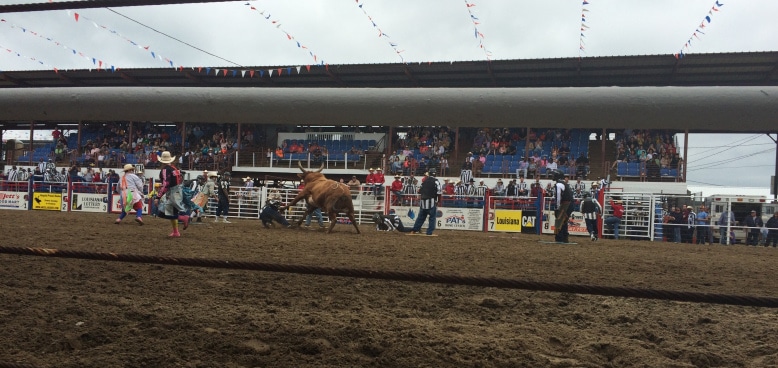Senior WJP journalist Ruth Hopkins is spending two and a half months in the United States with the Equal Justice Initiative in Montgomery and the Marshall Project in New York, investigating the similarities between issues facing both the American and South African criminal justice systems. Ruth will be detailing her journey through weekly blog posts published every Friday.
Angola prison, formally known as the Louisiana State Penitentiary, is built on 18,000 acres of land in a river basin nestled in between the Mississippi river and Lake Killarney. It would be beautiful if I hadn’t seen the disturbing pictures of African American prisoners picking cotton while a big white guy on a horse oversees their work. Angola prison takes its name from the Angolan slaves who picked cotton on the slave plantation that used to thrive on these very grounds.
The biannual prison rodeo at Angola prison attracts thousands of visitors every year, most of whom are unaware of the history of the prison. Food stands offer Southern delicacies from Cajun dishes and sugar sweet ice tea to ‘tornado potatoes’ and fried pickles.
Angola prison was long called the ‘bloodiest prison in America’, known for its stabbings and general violence among and toward the inmates. When warden Burl Cain took over the prison twenty years ago he managed to bring about a sharp decline in violence through various religious programmes, offering college degrees in ministry, making him the darling of reform-minded Christian Republicans.
Louisiana is the world’s prison capital as it imprisons the highest number of people in America, which has the highest incarceration rate in the world. One in every 86 adult Louisianian goes to prison. One in seven African American is either in prison, on parole or probation.
The prisoners showcasing their work at the arts and crafts fair at the ‘prison festival’ are ‘trustees’; they have had a clean disciplinary record for several years. Those who are well behaved can sell their wares from behind a fence. Leaning against the wire, their fingers clasped through the grid, they try to attract the attention of the visitors browsing the paintings, leather belts, jewellery and toys at the fair. I buy a chess set from Charles. He tells me, through the fence, that it is the only opportunity for prisoners to make some money. Despite taking a 20% cut of the sold arts and crafts and charging visitors a $20 entrance fee, the prisoners have to buy their own supplies.
Most men in Angola are sentenced to life without parole. This means they will die in prison. Some of them tell me it’s not the worst prison to be in. One inmate, who wants to remain anonymous, tells me: “If you show initiative you can make it work.” Others say it is hell inside – a modern day slave plantation – where there are violent guards and inmates, and bible study is the only way out.
The rodeo starts when the star spangled banner plays. Bucking bulls and kicking horses have inmates in striped black-and-white uniforms flying through the air. Even though the prisoners are kitted out with body armour and helmets, they resemble rag dolls, as they crash to the ground or are trampled on. In one of the many game variations called ‘convict poker’, four men sit around a table and the last one to get up and run away from the bull wins. One inmate limps away after a bull flings him to the ground. Another game is to have prisoners stand inside a hula hoop and wait for the bull to attack them; the last man standing wins. The crowd cheers and laughs at the rodeo clowns running around agitating the bulls.

“The rodeo is degrading and inhuman,” says Robert Hillary King, who is one of the Angola 3, a trio of men who were at the ugly coalface of the American criminal justice system for decades. Herman Wallace, Albert Woodfox and King were locked up in solitary confinement in Angola for years because, so they say, of their allegiance with the Black Panther Party. They were falsely accused of murdering a prison guard and a fellow prisoner in the early seventies when they were educating inmates to organise against the harsh prison conditions in Angola.
King spent 29 years in a cell the size of an average bathroom, a debilitating experience he writes about in his book.Woodfox was recently released after spending 43 years in an isolation cell. Wallace died three days after his release in 2013. If you want to imagine what solitary confinement is like check out the Guardian’s virtual experience here.
“We tried, as much as that was possible from our cells, to educate inmates about the exploitation of the rodeo,” King said in a recent interview. I will be writing more about him and Angola prison in articles follow. Gregory Bright, who spent 27 years in Angola for a crime he did not commit, agrees: “There were always guys who came back injured from the rodeo,” he says, “one guy had severe kidney problems after he was attacked by one of the bulls. He later died from complications. No one talks about that.” Both King and Bright cite boredom and desperation as a reason for the incarcerated men to elect to partake in the rodeo.
Visitors pile out of the prison compound when the bulls are back in their pens and the prisoners returned to their cells. I ask them, as they place their purchases in their cars, what impression the rodeo made.
“I have heard about the rodeo for years,” a young couple from upstate Louisiana tells me, “and I always wanted to go. It wasn’t as good as a real rodeo, because the prisoners can’t stay on the bull as long.”
Another couple, lecturers at a criminal justice college in Texas, thinks it is a wonderful chance for the prisoners to mix with family members and friends and to interact with the outside world. The man adds that he really enjoyed the rodeo, which he says would impossible in Texas. When I ask him why, he shrugs and says: “health and safety.
